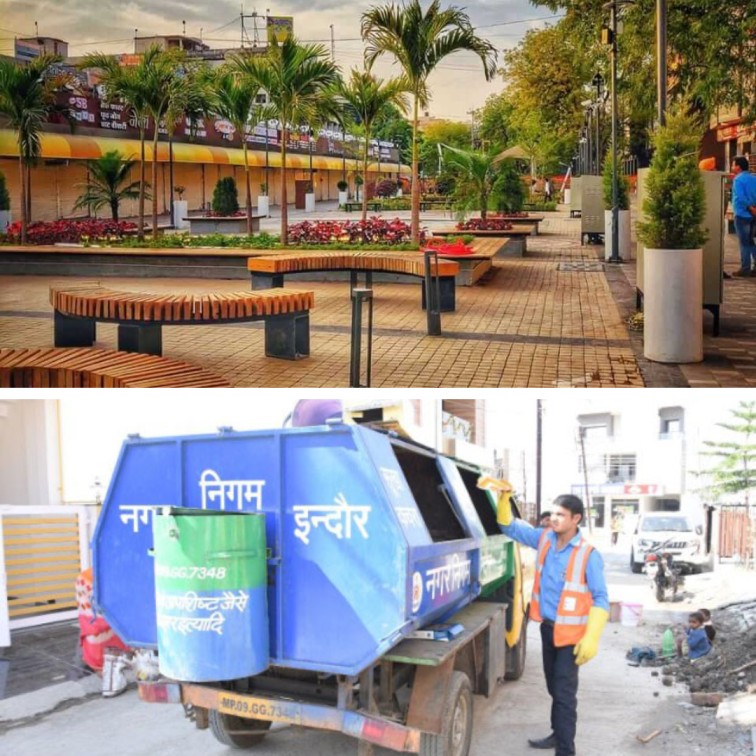
Image Credits: Smart City Indore, Smart City Indore
Here's How Indore's Solid Waste Management Model Is Paving Way For Uttar Pradesh Government
Writer: Jayali Wavhal
She writes about gender issues, human interest, and environment.
Madhya Pradesh, 24 Nov 2022 9:15 AM GMT
Editor : Shiva Chaudhary |
A post-graduate in Journalism and Mass Communication with relevant skills, specialising in content editing & writing. I believe in the precise dissemination of information based on facts to the public.
Creatives : Jayali Wavhal
She writes about gender issues, human interest, and environment.
Ranked ‘cleanest city in India’ for the sixth consecutive time, Indore has mastered the process of waste management by involving citizens, private companies and non-governmental organisations under its administrative directive.
Involving citizens and non-governmental organisations (NGOs) in its scrupulous plan to efficiently process waste, Indore has earned the title of 'cleanest city in India' for the sixth time in a row as per the central government's annual cleanliness survey. The city has inspired other states to adopt a similar model, the latest example being that of Uttar Pradesh.
The Yogi Adityanath government will be taking inspiration from the 'Indore model' of solid waste management and implementing it throughout the urban bodies across UP. The state aims to ensure that its cities are greener, cleaner and sustainably planned. Officials of the state government visited Indore and extensively reviewed its cleanliness model.
What Is The Indore Model?
The Municipal Corporation of Indore has mastered the process of waste management by involving citizens, private companies and NGOs under political and administrative directives. Every morning, households are required to segregate waste into dry and wet categories. Using the comprehensive route plan, garbage trucks achieve 100 per cent door-to-door waste collection, providing timely service to everyone. This has helped eliminate the need for garbage bins, making Indore a 'Bin-free city'.
The number of garbage trucks designated for each area was decided after mapping the number of households in each area, after which information about these vehicles and the time of pickup was distributed widely, The Indian Express reported.
Garbage transfer stations were constructed at several locations across the city so that the garbage trucks could offload excess waste and continue on their route without disrupting the pickup schedule. The vehicles are geotagged and are not only tracked by the central control and command centre of the city but also by the general public. In case of any delay or discrepancy, an alert is sent to the command centre, the respective ward members and officials, thus ensuring maximum efficiency and accountability.
The Indore Model also takes into account the fuel usage of the garbage trucks. The initial survey stated that garbage vehicles were not equipped to carry waste beyond a certain weight limit. However, officials modified the design of these vehicles – all within the RTO guidelines and limits – and found that the redesigned vehicles could carry much more waste.
While the old trucks could carry the waste generated from 300-400 households initially, the new trucks could carry waste generated from 1000-1200 households. This helped the city save on fuel and energy while optimising available resources.
Involving NGOs To Create Awareness
To achieve 100 per cent waste segregation at the household level, city administration could not afford to be lenient with repeated mistakes committed by households due to poor awareness campaigns. Hence, NGOs were roped in for the particular task.
The volunteers from the NGOs would visit the households at the time of waste collection and educate them on how to segregate waste before it is transferred into the garbage trucks. Volunteers also sensitised people about the importance of waste segregation and how the city can achieve its cleanliness goals with cooperation. Citizens were also informed about the fine and penal structure for violating any of the rules; while the initial fine was ₹ 50 to ₹ 200, it has now gradually increased to ₹ 1 lakh as a spot fine.
Results Of Waste Management System
India has several poisonous landfills and garbage heaps, the biggest one being the Deonar ground in Mumbai. Two primary reasons for the formation of these landfills are less capacity for processing waste and the unsegregated collection of waste.
Through its extensive planning, Indore can process 1200 tonnes of waste in a single day. This means there are no garbage heaps or landfills in the city which often are a breeding ground for several diseases.
The city has won the title of the cleanest city in India for six consecutive years and is now inspiring other states to become cleaner and greener.
Also Read: Safety Round The Clock! Nellore Police Rescue Woman Who Sent SOS Alert Through Disha App
 All section
All section














